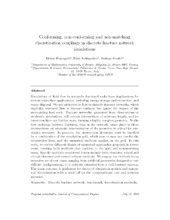| dc.contributor.author | Fumagalli, Alessio | |
| dc.contributor.author | Keilegavlen, Eirik | |
| dc.contributor.author | Scialo, Stefano | |
| dc.date.accessioned | 2020-06-22T12:47:25Z | |
| dc.date.available | 2020-06-22T12:47:25Z | |
| dc.date.issued | 2019 | |
| dc.Published | Fumagalli A, Keilegavlen E, Scialo S. Conforming, non-conforming and non-matching discretization couplings in discrete fracture network simulations. Journal of Computational Physics. 2019;376:694-712 | eng |
| dc.identifier.issn | 0021-9991 | en_US |
| dc.identifier.issn | 1090-2716 | en_US |
| dc.identifier.uri | https://hdl.handle.net/1956/22807 | |
| dc.description.abstract | Simulations of fluid flow in naturally fractured rocks have implications for several subsurface applications, including energy storage and extraction, and waste disposal. We are interested in flow in discrete fracture networks, which explicitly represent flow in fracture surfaces, but ignore the impact of the surrounding host rock. Fracture networks, generated from observations or stochastic simulations, will contain intersections of arbitrary length, and intersection lines can further cross, forming a highly complex geometry. As the flow exchange between fractures, thus in the network, takes place in these intersections, an adequate representation of the geometry is critical for simulation accuracy. In practice, the intersection dynamics must be handled by a combination of the simulation grid, which may or may not resolve the intersection lines, and the numerical methods applied on the grid. In this work, we review different classes of numerical approaches proposed in recent years, covering both methods that conform to the grid, and non-matching cases. Specific methods considered herein include finite elements, mixed and virtual elements and control volume methods. We expose our methods to an extensive set of test cases, ranging from artificial geometries designed to test difficult configurations, to a network extruded from a real fracture outcrop. The main outcome is guidances for choice of simulation models and numerical discretization with a trade off on the computational cost and solution accuracy. | en_US |
| dc.language.iso | eng | eng |
| dc.publisher | Elsevier | en_US |
| dc.rights | Attribution-NonCommercial-NoDerivs CC BY-NC-ND | eng |
| dc.rights.uri | http://creativecommons.org/licenses/by-nc-nd/4.0/ | eng |
| dc.title | Conforming, non-conforming and non-matching discretization couplings in discrete fracture network simulations | en_US |
| dc.type | Peer reviewed | |
| dc.type | Journal article | |
| dc.date.updated | 2020-02-18T12:24:54Z | |
| dc.description.version | acceptedVersion | en_US |
| dc.rights.holder | Copyright 2018 Elsevier | en_US |
| dc.identifier.doi | https://doi.org/10.1016/j.jcp.2018.09.048 | |
| dc.identifier.cristin | 1695834 | |
| dc.source.journal | Journal of Computational Physics | |
| dc.source.pagenumber | 694-712 | |
| dc.identifier.citation | Journal of Computational Physics. 2019;376:694-712 | |
| dc.source.volume | 376 | |

